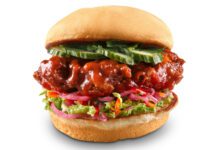Tim Hortons’ new president and CEO, Marc Caira, shares strategy, innovations and his plans for the company in this highlight from F&H’s Icons & Innovators Breakfast series.
Rosanna Caira: Why, after a self-imposed retirement, are you now leading the country’s number-1 brand?
Marc Caira: I was very fortunate to have worked for a company like Nestlé for so many years, to have left Nestlé after 25 years. I was also very fortunate to hook up with Parmalat, and I had six wonderful years with them. I was invited to return to Nestlé … but it also meant moving to Switzerland … and I made it very clear I’d make a commitment for five years and then I’d come back…. I finally convinced Nestlé it was okay to retire at 58. I retired to come home. Was I going to do something? Absolutely.The Tim Hortons opportunity came up after the fact, when it was announced that I was retiring. Paul House called me and said ‘Marc, we’ve known you since 1977, and we’ve watched you. I came back here as an interim president and CEO, and I see that you’re retiring — you should come and talk to us. We’re looking for a CEO.’ The first time, I said no … but he insisted, so I made the trip to Toronto, and I also met with another very interesting individual named Frank Iacobucci [lead director on the Tim Hortons Board]. It ended up that Frank’s mother and our family came from the same village in Italy. There was an instant connection. By the time Frank was finished with me, and Paul was finished with me, we came to an agreement that I would join Tim Hortons as president and CEO.
RC: What do you say to people who say you don’t have enough operations experience?
MC: They’re right. I don’t have restaurant experience. It’s the truth — having said that, when you look at the role of a CEO today, it’s very different than it was a few years ago when I started in the industry. [It] encompasses a lot, including being able to interact and engage with shareholders, being able to engage with the industry. A lot of the governance stuff that we didn’t worry about in the past is very important to me. It’s very difficult to find someone who’s going to tick all the slots. And I think the Board tried…. I have one of the best, strongest teams at Tim Hortons — the management team. And there is a lot of strength on that team. So I don’t have to be strong operationally; I bring strength in other areas. Perhaps we need to have more focus on strategy; perhaps we need to better understand the consumer, maybe a bit more focus on the marketing side, which is something I’m more familiar with.
RC: What is your vision for the brand?
MC: There are some challenges we have to address, but this is not a transformational challenge; it’s what I would call an evolutionary challenge…. My responsibility is to build on a solid foundation that this brand enjoys today, and bring it to the next level. Not alone, but with the help of my colleagues…. We need to instill urgency in terms of getting things done and moving on. Tim Hortons was known for being bold and daring and different. You’re going to see more of that Tim Hortons in the future. One of the first things I did when I got here was, we jumped on an airplane and went to 21 cities in 11 days, and met with the most important people in our business — our franchisees. They’re the frontlines. We listened to them, and we engaged them. What I heard was we need to be more aggressive, we need to act like the leaders we are, we need more innovation. Coffee is our sacred cow, and we’re going to be more aggressive on coffee. We will control the agenda on coffee. This is a fantastic brand that needs to assert itself…. The role of the head office is to support the markets. Our job is to make sure the markets win, to make sure the restaurants win.
RC: How would you define Tim Hortons today?
MC: This restaurant looks completely different than it did five years ago. You have to keep evolving to meet the needs of your consumers, and you have to know and anticipate where that consumer is going. That’s one of the challenges. I’d say that a lot of our success in the past is that we’ve built new restaurants, and we’ve expanded very quickly. We’ve got 3,500 in Canada, 800 in the U.S., and some in the Middle East. So, a lot of our growth came from building new restaurants…. But you’re going to have to look for new ways to grow. And here we talk about same-store sales and innovation. It’s innovation that is differentiated. A lot of people can innovate, but what makes your innovation so different that it’s going to make the consumer come to you? One of the criticisms I have of this industry is that we’re all starting to look the same. And we’re all trying to compete on price and who’s got the lowest price in the market. And that’s dangerous, because once you get on that road, there’s no telling when you’re going to hit the bottom.
RC: How are you going to innovate?
MC: Consumer insights, consumer intelligence is critical. You’re going to see us increase that significantly…. More and more people are looking for healthier options, and we have to be sure we offer that. Technology is another area — we’ve been slow with technology. The last six months, we’ve sped up. When you look at these new consumers, they live off the smartphone. We have to accommodate that. So we have. We have mobile payments, pre-payments, you can order off your mobiles now. We’re going from 11 POS to one POS. [There’s our new] Double-Double card, our new loyalty card [due out in the summer]. It’s a credit card that you get for free. You can go into Future Shop and push this little button to activate the credit card, buy a TV for $1,000, and one per cent of that purchase price will be credited to your Tim card. Then you can go next door to Tim Hortons, push a button, and use it as a Tim’s card. This is an example of differentiated innovation, and that’s what we’ve got to do.
RC: What’s the solution to recent declines in out-of-home coffee consumption?
MC: The market is down, but it’s also a very fragmented market. Two quarters is not really an indicator…. One of the criticisms I had is ‘We have 76-per-cent share of this business, but we’ve had one blend for 50 years.’ In this environment, you can’t do it with one blend anymore. We’re testing some new blends that we hope to roll out. We’re testing some new equipment we’re hoping to roll out. Coffee is our sacred cow. We’ve let other people try and control the agenda, but that ain’t going to happen anymore. We’re going to drive this thing now.
RC: What growth do you anticipate?
MC: Five hundred restaurants between now and 2018, but that’s just the beginning. If you walk around downtown Toronto, we’re not happy with the number of restaurants. It’s not just Toronto — it’s urban centres. This brand started in small communities and worked its way in, but we haven’t really penetrated areas like Toronto and Vancouver. So, there will be more focus in urban centres. You’re going to see smaller formats, smaller footprints, smaller boxes, kiosks. In downtown Toronto alone, between Jarvis, University, Bloor and Lakeshore, we’re going to have 50 new restaurants over the next couple years. Our business will always be restaurants, but there are also opportunities to take our business beyond restaurants…. We’re going to take single-serve from not only being available in our restaurants but also available in other channels. [We are introducing] Tim Hortons single-serve coffee in supermarkets. And there will be other products to follow. Ready-to-drink is another area — one of the fastest-growing areas. Our focus, our heritage is coffee. But why should we not have ready-to-drink coffee beverages from Tim Hortons in other stores, in convenience stores?
RC: How is expansion faring in the U.S.?
MC: We weren’t happy with our performance in the U.S. But we learned things about the U.S. business. First and foremost, it’s not the same as Canada…. You have to respect the fact that there’s no such thing as a global consumer. Consumers are local with local taste. So we put a team in place that does nothing but focus on the U.S. And the head of that team is our president for the U.S., Mike Meilleur…. We did extensive research of those markets that we’re in and the good news is we have two things — we have awareness and we have convenience. People know who we are and what we stand for.
RC: You have a different name in the U.S.
MC: In Canada, everyone knows who we are. In the U.S., very few people knew who we were, so we had to establish an identity, which is Cafe & Bake Shop. So, our business in the U.S. is really a morning business, a breakfast and coffee business. The fact that we have awareness and convenience tells us that the challenge we have is to build loyalty beyond the morning daypart…. The other strategy — we’re not going to use our own money anymore. We’re going to align ourselves with the right partners. People who not only have capital, but people who understand the market, people who have access to real estate, media, supply chain. It’s a slightly different model than what we’re accustomed, but it’s a model that will allow us to go faster than we have in the past.
RC: What does the U.S. expansion look like?
MC: I think we said 300 for the next five years. To me, the important thing is not how many restaurants you’re going to open, but that you have almost 900 restaurants today. How do you maximize those? The way we’re going to get that return is to build business beyond the breakfast daypart.
RC: You also have units in the Gulf Cooperation Council.
MC: The partner there is somebody called The Apparel Group. And these people know the market intimately, they have access to real estate, they control a lot of the malls, they have access to media, they have a lot of money, and they believe in the brand. It was an opportunity to align with the right partners in a very important part of the world, since it’s a gateway, and it’ll get us a lot of exposure. We didn’t put any capital in — the capital is put in by our partner, and we take a royalty. Each month we get a cheque. It’s a model we’re looking to expand in other parts of the world, so that’s something to look forward to in the coming months.
For full Interviews, visit here.




















